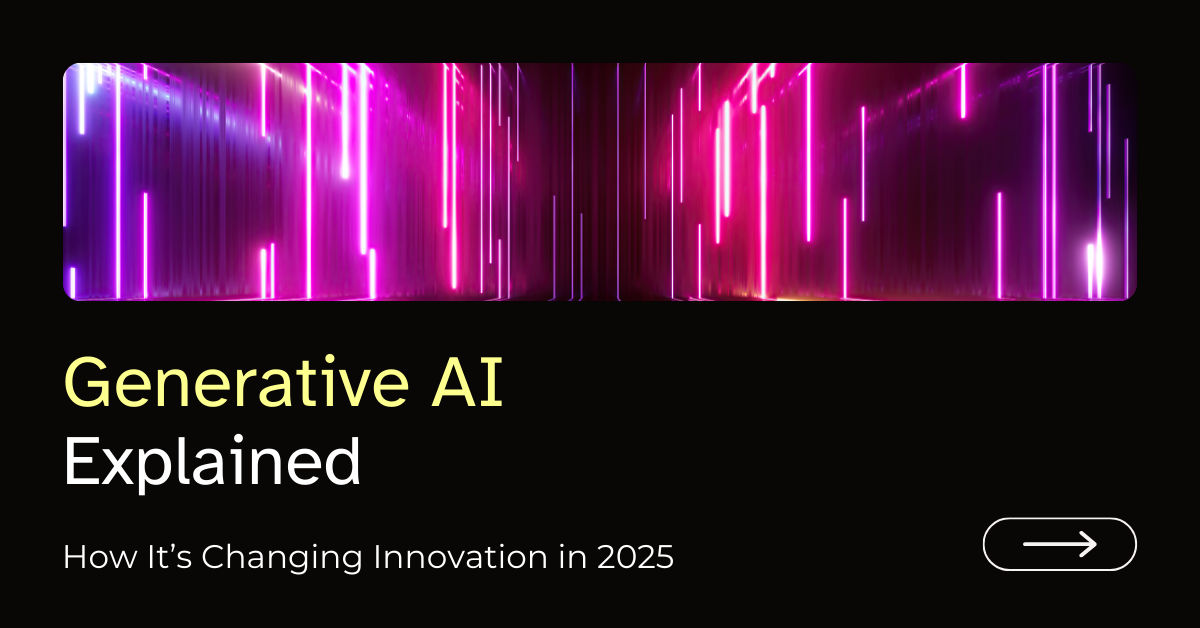Generative AI is a type of artificial intelligence that has the remarkable ability to create new things such as text, images, music, and even videos by identifying and learning patterns from existing data. It’s more than just cutting-edge technology—it’s something that’s already part of our daily lives, often without us even realizing it.
When you use a chatbot to ask for help, let your phone suggest the next word in your text, or watch an AI-generated movie trailer, you’re experiencing the magic of Generative AI. This technology is changing how we interact with the world by helping artists craft unique creations, automating tedious tasks, and even making personalized recommendations on our favorite streaming platforms. Generative AI is everywhere, transforming industries and enhancing our day-to-day experiences.
Let’s dive into what it is, how it works, and why it’s such a game-changer.
What is Generative AI?
Generative AI is a special kind of AI that doesn’t just analyze data—it creates new content. For example, it can write stories, draw pictures, or compose songs. Unlike other types of AI that focus on sorting or predicting, Generative AI uses its creativity to come up with original ideas. It’s like giving a machine the ability to imagine and create, which opens up limitless possibilities.
Why Is Generative AI Important?
Generative AI helps people save time and explore new ideas that might be difficult or time-consuming to create from scratch. It has become popular because of breakthroughs in tools that can create highly realistic pictures (like DALL·E) or write human-like text (like ChatGPT). These tools are not just powerful but also user-friendly, making them accessible to everyone from professionals to hobbyists.
A Brief History
Generative AI has its roots in the development of models like Generative Adversarial Networks (GANs) in 2014. These models allowed computers to generate realistic images for the first time. Over the years, advancements in technology led to tools like GPT (Generative Pre-trained Transformer), which made it possible for AI to generate human-like text. Today, Generative AI is used in industries ranging from entertainment to healthcare, showing how far it has come in a short period.
How Does Generative AI Work?
Generative AI works by studying large amounts of data and learning patterns. Then, it uses what it’s learned to make new content. Here’s a closer look at how it exactly works:
-
Types of Models:
-
GANs (Generative Adversarial Networks): These consist of two parts—a generator that creates new data and a discriminator that evaluates how realistic the data is. They work together to produce lifelike outputs, such as realistic images.
-
Transformers: These models, like GPT, excel at understanding and generating text by looking at patterns in sentences and paragraphs. They’re the backbone of many AI tools today.
-
Training:
-
Gen AI models are basically trained on a huge amount of data. They analyze this data, try to guess what comes next, and adjust their guesses to improve. This process, repeated millions of times, helps the model become more accurate and creative.
-
Using Data:
-
The quality of what Generative AI creates depends massively on the data it’s trained on. For example, if a model is trained on books, it will be good at writing stories. If it’s trained on paintings, it will excel at creating art.
What Is the Main Goal of Generative AI?
The main goal of Generative AI is to make new and meaningful content. This can help in many ways:
-
Helping Creativity:
-
Generative AI acts as a partner for artists, writers, and designers, helping them come up with ideas, create prototypes, or finish projects faster.
Real-Life Examples
What Type of Data is Generative AI Most Suitable For?
If you want to know what is generative AI select the best option, you need to understand there are 2 types of data:
-
Structured Data:
-
Organized information, like tables, spreadsheets, or numerical patterns. This type of data is often used in fields like finance or logistics.
-
Unstructured Data:
-
Unorganized information, like text, images, videos, or audios. Generative AI shines when working with this type of data, as it’s what most creative content is made of.
Why Good Data Matters
The better the data, the better the results. For example:
What is Generative AI Primarily Used For?
Generative AI is transforming industries. Let’s explore some examples:
-
Content Creation:
-
Generative AI could help you create videos, blogs, and images, designs faster and more efficiently than ever before.
-
Design:
-
AI models can generate new product designs, architectural plans, or fashion prototypes, saving time and sparking innovation.
Some Business Uses
Businesses leverage Generative AI to make personalized marketing campaigns, provide 24/7 customer support through chatbots, and predict market trends. These applications save both time and money while improving customer satisfaction.
Challenges and Ethical Concerns
Generative AI is powerful, but it also comes with challenges:
Technical Issues
-
Data Quality: Generative AI needs a lot of clean, high-quality data to produce good results. Bad data leads to poor outputs.
-
Cost: Training large AI models requires expensive hardware and a lot of energy.
-
Complexity: It’s often difficult to understand how AI makes certain decisions, which can be a problem in sensitive fields like healthcare.
Ethical Concerns
-
Bias: If the training data contains biases, the AI’s output will too. This can reinforce harmful stereotypes.
-
Misuse: Generative AI can create deepfakes or spread false information, leading to ethical dilemmas.
-
Ownership: There’s ongoing debate about who owns the content generated by AI—the creator of the AI or the user of the tool.
Addressing these challenges requires collaboration between developers, businesses, and policymakers to ensure responsible use.
What’s Next for Generative AI?
New Trends
-
Multimodal Models: Combining text, images, and sounds in one tool to create even more powerful AI applications.
-
Better Control: Researchers are working on ways to make Generative AI more predictable and easier to guide.
Future Predictions
-
Generative AI is expected to personalize learning in schools and improve patient and healthcare in hospitals.
-
It will likely become a common tool in everyday life, from helping with work tasks to enhancing hobbies.
Try Generative AI Yourself!
Want to see Generative AI in action? Here’s how:
-
Text: Use ChatGPT to write a story, poem, or email in seconds.
-
Images: Create stunning visuals with tools like DALL·E or MidJourney by describing what you want.
-
Code: Speed up your programming projects with GitHub Copilot’s intelligent suggestions.
These tools are easy to use and open up creative opportunities for everyone, regardless of their background.
What is A Token in Generative AI?
Tokens in Generative AI are basically building blocks of the text generated by it. Here’s how they work:
-
What Are Tokens?
-
Example:
Tokens help AI understand and create text, breaking it down into manageable pieces for better processing.
FAQs and Misconceptions
FAQs
-
What makes Generative AI special?
-
Does it have limits?
-
How does it learn?
Myths
Before diving into common myths about Generative AI, it’s important to set the stage. Many misconceptions exist about how this technology works and what it means for creativity, usability, and society as a whole. Let’s clear up some of the most popular and common myths:
Conclusion
Generative AI is an exciting technology that’s reshaping how we create and work. It can write, draw, and solve problems in ways we’ve never seen before. By understanding how it works and using it responsibly, we can unlock its full potential and make the most of its capabilities.




